External Market Environment Analysis: NZ Beef Export to South Korea
VerifiedAdded on 2022/09/14
|7
|1782
|25
Report
AI Summary
This report analyzes the external market environment for New Zealand beef exports to South Korea, focusing on political, legal, and socio-cultural factors. The analysis examines the challenges and opportunities, including the impact of trade agreements, consumer preferences, and cultural considerations. It explores factors like the influence of the US beef market, import regulations, and the evolving consumption patterns of the South Korean population. The report also considers socio-cultural elements such as religious influences, dietary habits, and the increasing trend towards vegetarianism. Furthermore, the report considers demographic aspects such as aging population and fertility rates, as well as the impact of technology and working conditions. The report concludes with an overall recommendation regarding the feasibility of exporting beef to South Korea and suggests strategic approaches for market entry and success, referencing relevant academic literature throughout.
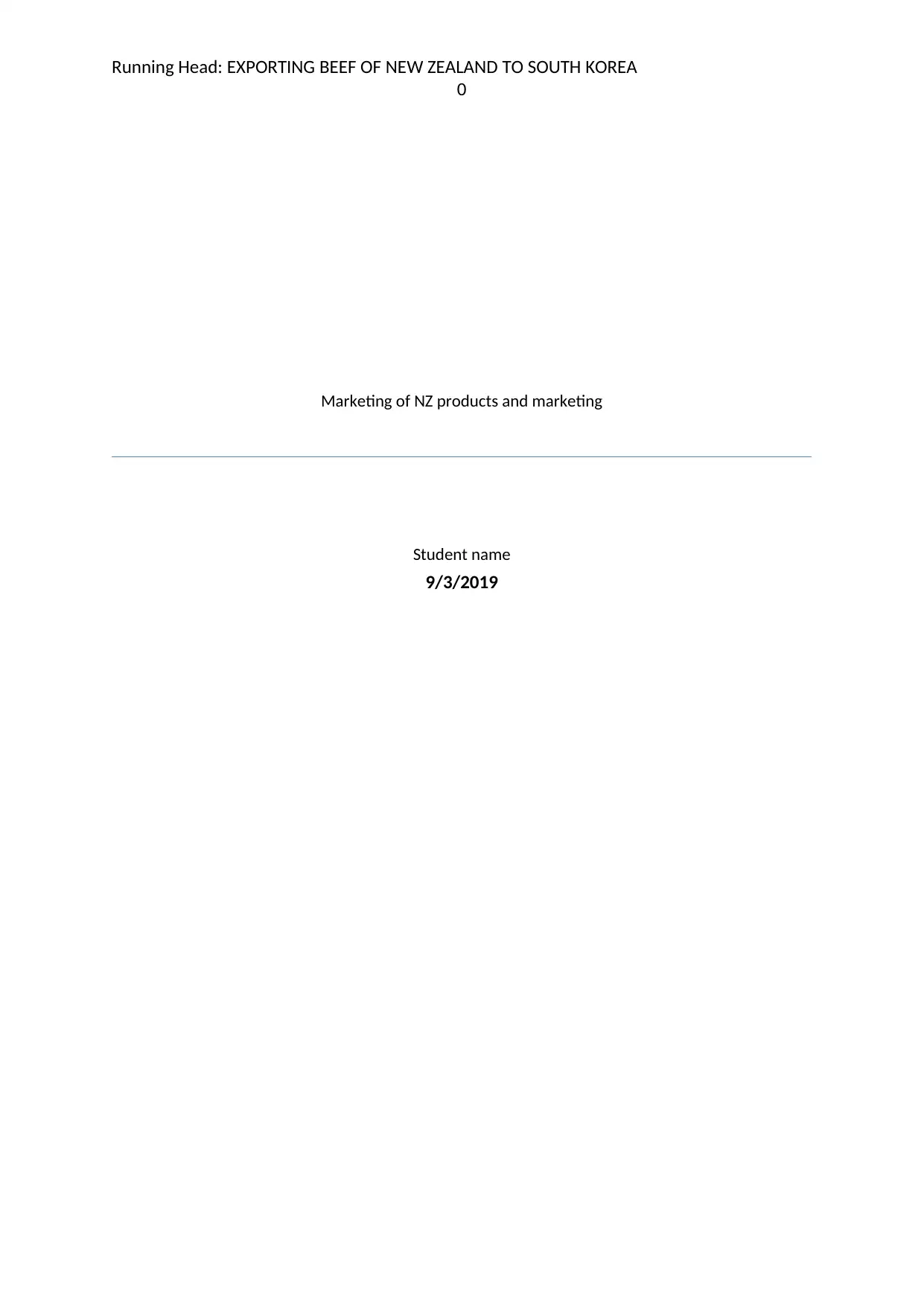
Running Head: EXPORTING BEEF OF NEW ZEALAND TO SOUTH KOREA
0
Marketing of NZ products and marketing
Student name
9/3/2019
0
Marketing of NZ products and marketing
Student name
9/3/2019
Paraphrase This Document
Need a fresh take? Get an instant paraphrase of this document with our AI Paraphraser
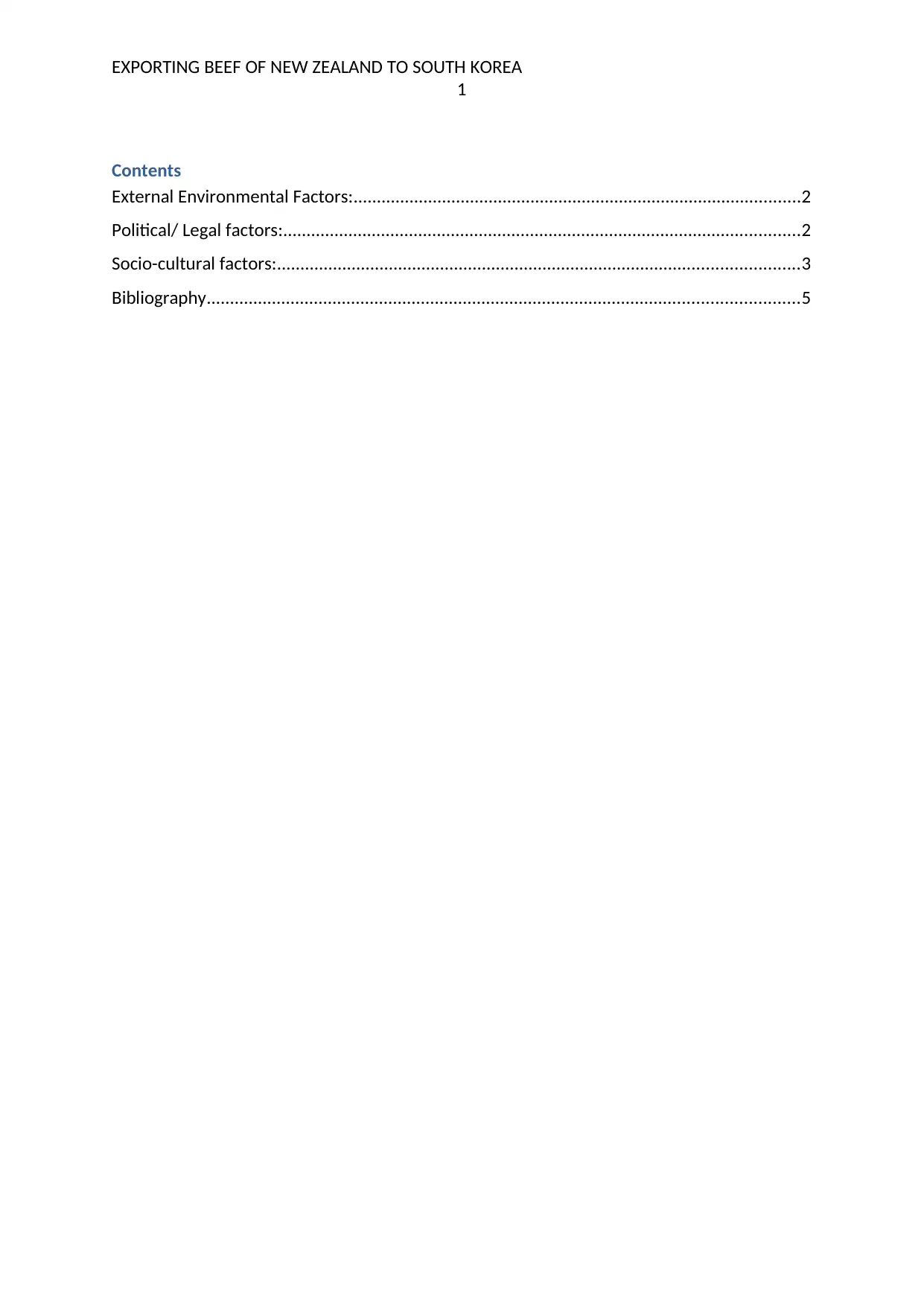
EXPORTING BEEF OF NEW ZEALAND TO SOUTH KOREA
1
Contents
External Environmental Factors:................................................................................................2
Political/ Legal factors:...............................................................................................................2
Socio-cultural factors:................................................................................................................3
Bibliography...............................................................................................................................5
1
Contents
External Environmental Factors:................................................................................................2
Political/ Legal factors:...............................................................................................................2
Socio-cultural factors:................................................................................................................3
Bibliography...............................................................................................................................5
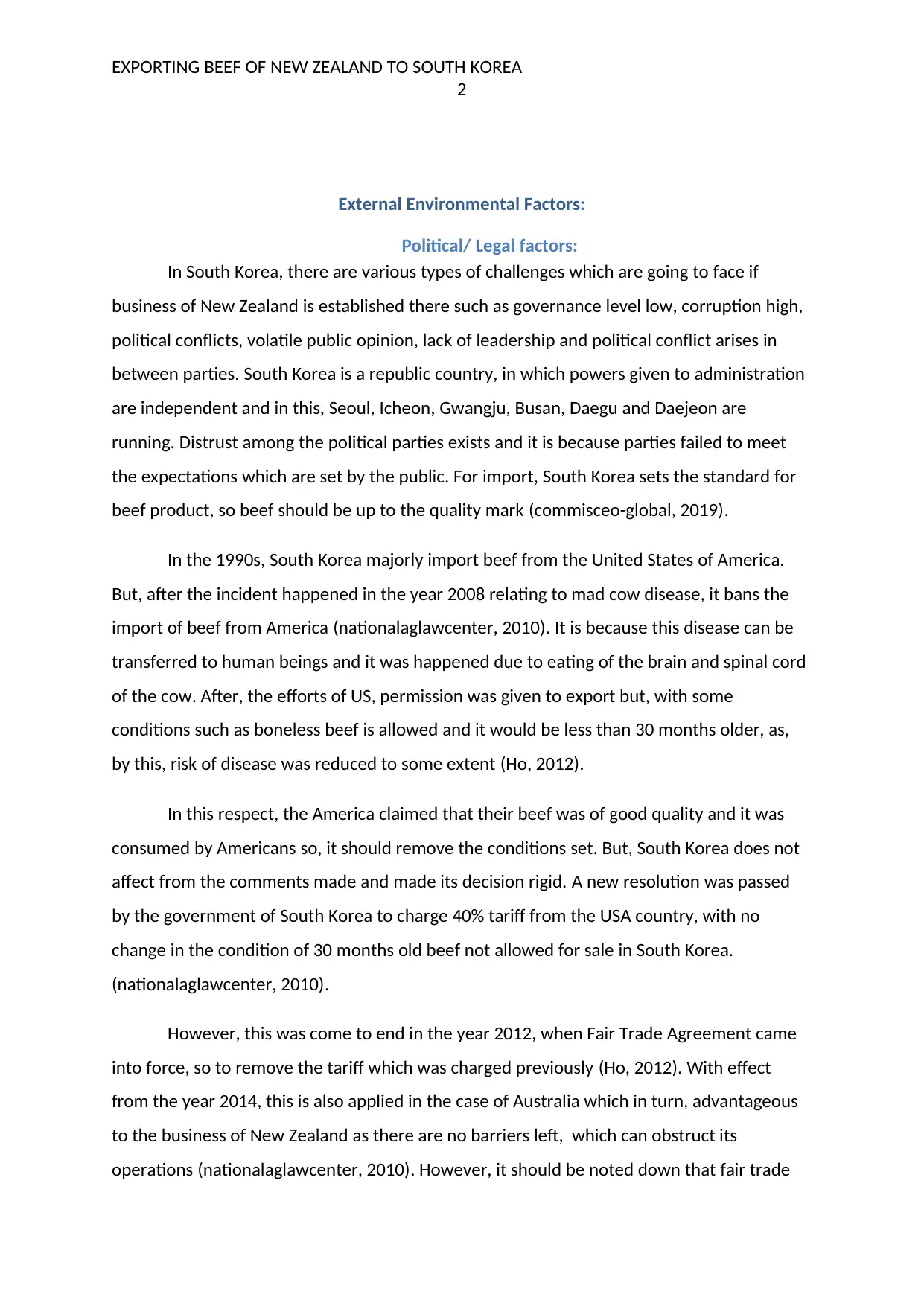
EXPORTING BEEF OF NEW ZEALAND TO SOUTH KOREA
2
External Environmental Factors:
Political/ Legal factors:
In South Korea, there are various types of challenges which are going to face if
business of New Zealand is established there such as governance level low, corruption high,
political conflicts, volatile public opinion, lack of leadership and political conflict arises in
between parties. South Korea is a republic country, in which powers given to administration
are independent and in this, Seoul, Icheon, Gwangju, Busan, Daegu and Daejeon are
running. Distrust among the political parties exists and it is because parties failed to meet
the expectations which are set by the public. For import, South Korea sets the standard for
beef product, so beef should be up to the quality mark (commisceo-global, 2019).
In the 1990s, South Korea majorly import beef from the United States of America.
But, after the incident happened in the year 2008 relating to mad cow disease, it bans the
import of beef from America (nationalaglawcenter, 2010). It is because this disease can be
transferred to human beings and it was happened due to eating of the brain and spinal cord
of the cow. After, the efforts of US, permission was given to export but, with some
conditions such as boneless beef is allowed and it would be less than 30 months older, as,
by this, risk of disease was reduced to some extent (Ho, 2012).
In this respect, the America claimed that their beef was of good quality and it was
consumed by Americans so, it should remove the conditions set. But, South Korea does not
affect from the comments made and made its decision rigid. A new resolution was passed
by the government of South Korea to charge 40% tariff from the USA country, with no
change in the condition of 30 months old beef not allowed for sale in South Korea.
(nationalaglawcenter, 2010).
However, this was come to end in the year 2012, when Fair Trade Agreement came
into force, so to remove the tariff which was charged previously (Ho, 2012). With effect
from the year 2014, this is also applied in the case of Australia which in turn, advantageous
to the business of New Zealand as there are no barriers left, which can obstruct its
operations (nationalaglawcenter, 2010). However, it should be noted down that fair trade
2
External Environmental Factors:
Political/ Legal factors:
In South Korea, there are various types of challenges which are going to face if
business of New Zealand is established there such as governance level low, corruption high,
political conflicts, volatile public opinion, lack of leadership and political conflict arises in
between parties. South Korea is a republic country, in which powers given to administration
are independent and in this, Seoul, Icheon, Gwangju, Busan, Daegu and Daejeon are
running. Distrust among the political parties exists and it is because parties failed to meet
the expectations which are set by the public. For import, South Korea sets the standard for
beef product, so beef should be up to the quality mark (commisceo-global, 2019).
In the 1990s, South Korea majorly import beef from the United States of America.
But, after the incident happened in the year 2008 relating to mad cow disease, it bans the
import of beef from America (nationalaglawcenter, 2010). It is because this disease can be
transferred to human beings and it was happened due to eating of the brain and spinal cord
of the cow. After, the efforts of US, permission was given to export but, with some
conditions such as boneless beef is allowed and it would be less than 30 months older, as,
by this, risk of disease was reduced to some extent (Ho, 2012).
In this respect, the America claimed that their beef was of good quality and it was
consumed by Americans so, it should remove the conditions set. But, South Korea does not
affect from the comments made and made its decision rigid. A new resolution was passed
by the government of South Korea to charge 40% tariff from the USA country, with no
change in the condition of 30 months old beef not allowed for sale in South Korea.
(nationalaglawcenter, 2010).
However, this was come to end in the year 2012, when Fair Trade Agreement came
into force, so to remove the tariff which was charged previously (Ho, 2012). With effect
from the year 2014, this is also applied in the case of Australia which in turn, advantageous
to the business of New Zealand as there are no barriers left, which can obstruct its
operations (nationalaglawcenter, 2010). However, it should be noted down that fair trade
⊘ This is a preview!⊘
Do you want full access?
Subscribe today to unlock all pages.

Trusted by 1+ million students worldwide
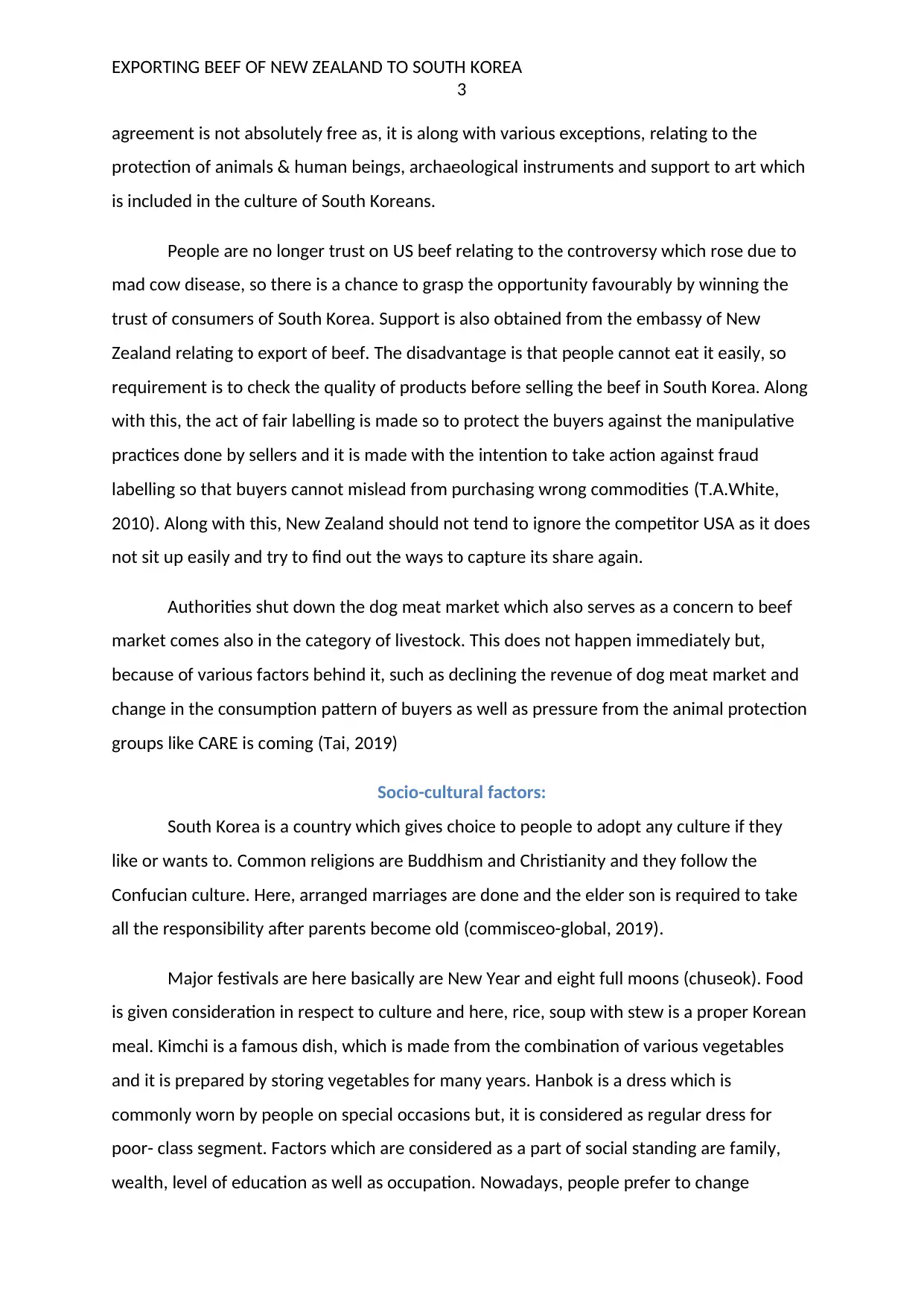
EXPORTING BEEF OF NEW ZEALAND TO SOUTH KOREA
3
agreement is not absolutely free as, it is along with various exceptions, relating to the
protection of animals & human beings, archaeological instruments and support to art which
is included in the culture of South Koreans.
People are no longer trust on US beef relating to the controversy which rose due to
mad cow disease, so there is a chance to grasp the opportunity favourably by winning the
trust of consumers of South Korea. Support is also obtained from the embassy of New
Zealand relating to export of beef. The disadvantage is that people cannot eat it easily, so
requirement is to check the quality of products before selling the beef in South Korea. Along
with this, the act of fair labelling is made so to protect the buyers against the manipulative
practices done by sellers and it is made with the intention to take action against fraud
labelling so that buyers cannot mislead from purchasing wrong commodities (T.A.White,
2010). Along with this, New Zealand should not tend to ignore the competitor USA as it does
not sit up easily and try to find out the ways to capture its share again.
Authorities shut down the dog meat market which also serves as a concern to beef
market comes also in the category of livestock. This does not happen immediately but,
because of various factors behind it, such as declining the revenue of dog meat market and
change in the consumption pattern of buyers as well as pressure from the animal protection
groups like CARE is coming (Tai, 2019)
Socio-cultural factors:
South Korea is a country which gives choice to people to adopt any culture if they
like or wants to. Common religions are Buddhism and Christianity and they follow the
Confucian culture. Here, arranged marriages are done and the elder son is required to take
all the responsibility after parents become old (commisceo-global, 2019).
Major festivals are here basically are New Year and eight full moons (chuseok). Food
is given consideration in respect to culture and here, rice, soup with stew is a proper Korean
meal. Kimchi is a famous dish, which is made from the combination of various vegetables
and it is prepared by storing vegetables for many years. Hanbok is a dress which is
commonly worn by people on special occasions but, it is considered as regular dress for
poor- class segment. Factors which are considered as a part of social standing are family,
wealth, level of education as well as occupation. Nowadays, people prefer to change
3
agreement is not absolutely free as, it is along with various exceptions, relating to the
protection of animals & human beings, archaeological instruments and support to art which
is included in the culture of South Koreans.
People are no longer trust on US beef relating to the controversy which rose due to
mad cow disease, so there is a chance to grasp the opportunity favourably by winning the
trust of consumers of South Korea. Support is also obtained from the embassy of New
Zealand relating to export of beef. The disadvantage is that people cannot eat it easily, so
requirement is to check the quality of products before selling the beef in South Korea. Along
with this, the act of fair labelling is made so to protect the buyers against the manipulative
practices done by sellers and it is made with the intention to take action against fraud
labelling so that buyers cannot mislead from purchasing wrong commodities (T.A.White,
2010). Along with this, New Zealand should not tend to ignore the competitor USA as it does
not sit up easily and try to find out the ways to capture its share again.
Authorities shut down the dog meat market which also serves as a concern to beef
market comes also in the category of livestock. This does not happen immediately but,
because of various factors behind it, such as declining the revenue of dog meat market and
change in the consumption pattern of buyers as well as pressure from the animal protection
groups like CARE is coming (Tai, 2019)
Socio-cultural factors:
South Korea is a country which gives choice to people to adopt any culture if they
like or wants to. Common religions are Buddhism and Christianity and they follow the
Confucian culture. Here, arranged marriages are done and the elder son is required to take
all the responsibility after parents become old (commisceo-global, 2019).
Major festivals are here basically are New Year and eight full moons (chuseok). Food
is given consideration in respect to culture and here, rice, soup with stew is a proper Korean
meal. Kimchi is a famous dish, which is made from the combination of various vegetables
and it is prepared by storing vegetables for many years. Hanbok is a dress which is
commonly worn by people on special occasions but, it is considered as regular dress for
poor- class segment. Factors which are considered as a part of social standing are family,
wealth, level of education as well as occupation. Nowadays, people prefer to change
Paraphrase This Document
Need a fresh take? Get an instant paraphrase of this document with our AI Paraphraser
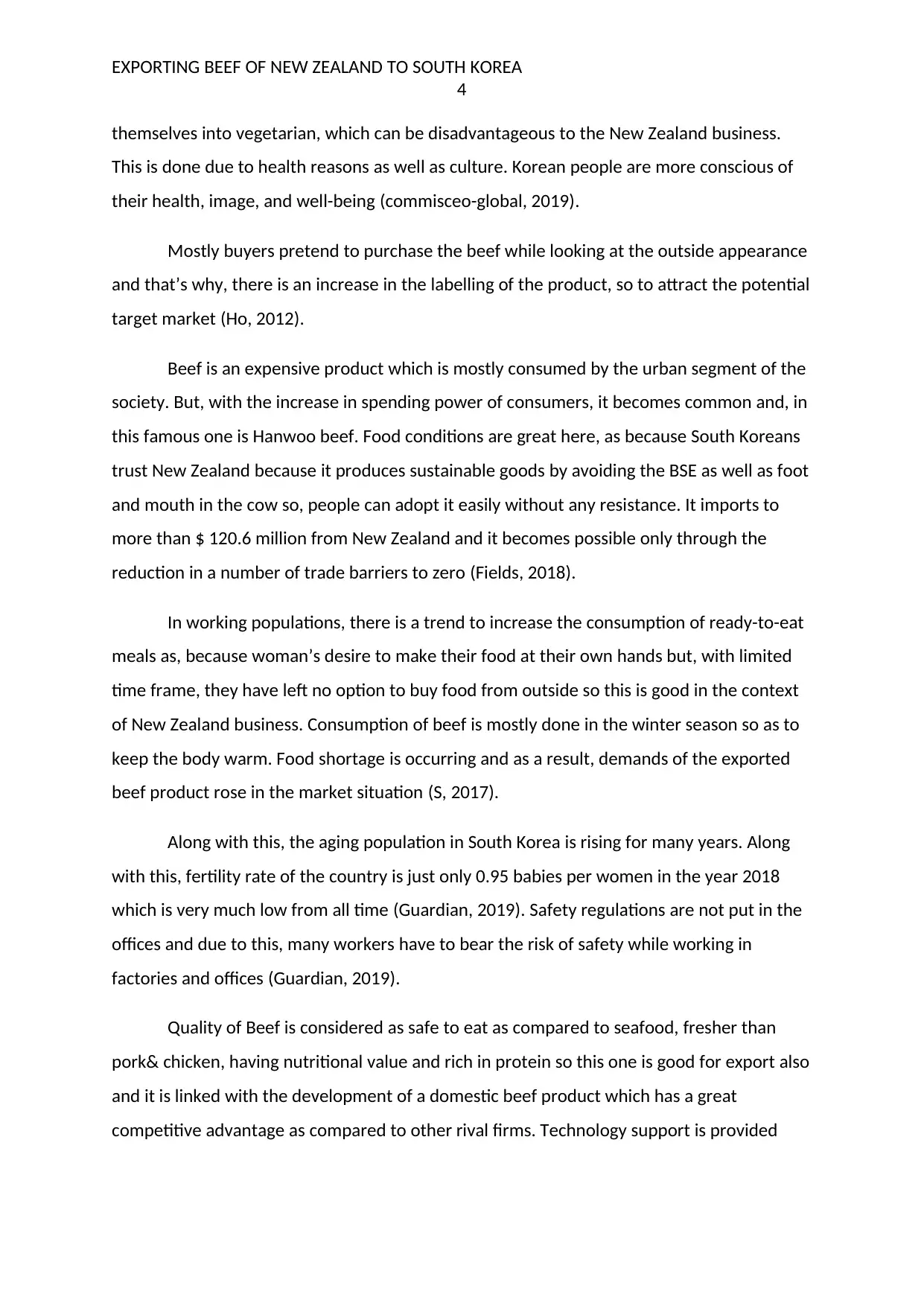
EXPORTING BEEF OF NEW ZEALAND TO SOUTH KOREA
4
themselves into vegetarian, which can be disadvantageous to the New Zealand business.
This is done due to health reasons as well as culture. Korean people are more conscious of
their health, image, and well-being (commisceo-global, 2019).
Mostly buyers pretend to purchase the beef while looking at the outside appearance
and that’s why, there is an increase in the labelling of the product, so to attract the potential
target market (Ho, 2012).
Beef is an expensive product which is mostly consumed by the urban segment of the
society. But, with the increase in spending power of consumers, it becomes common and, in
this famous one is Hanwoo beef. Food conditions are great here, as because South Koreans
trust New Zealand because it produces sustainable goods by avoiding the BSE as well as foot
and mouth in the cow so, people can adopt it easily without any resistance. It imports to
more than $ 120.6 million from New Zealand and it becomes possible only through the
reduction in a number of trade barriers to zero (Fields, 2018).
In working populations, there is a trend to increase the consumption of ready-to-eat
meals as, because woman’s desire to make their food at their own hands but, with limited
time frame, they have left no option to buy food from outside so this is good in the context
of New Zealand business. Consumption of beef is mostly done in the winter season so as to
keep the body warm. Food shortage is occurring and as a result, demands of the exported
beef product rose in the market situation (S, 2017).
Along with this, the aging population in South Korea is rising for many years. Along
with this, fertility rate of the country is just only 0.95 babies per women in the year 2018
which is very much low from all time (Guardian, 2019). Safety regulations are not put in the
offices and due to this, many workers have to bear the risk of safety while working in
factories and offices (Guardian, 2019).
Quality of Beef is considered as safe to eat as compared to seafood, fresher than
pork& chicken, having nutritional value and rich in protein so this one is good for export also
and it is linked with the development of a domestic beef product which has a great
competitive advantage as compared to other rival firms. Technology support is provided
4
themselves into vegetarian, which can be disadvantageous to the New Zealand business.
This is done due to health reasons as well as culture. Korean people are more conscious of
their health, image, and well-being (commisceo-global, 2019).
Mostly buyers pretend to purchase the beef while looking at the outside appearance
and that’s why, there is an increase in the labelling of the product, so to attract the potential
target market (Ho, 2012).
Beef is an expensive product which is mostly consumed by the urban segment of the
society. But, with the increase in spending power of consumers, it becomes common and, in
this famous one is Hanwoo beef. Food conditions are great here, as because South Koreans
trust New Zealand because it produces sustainable goods by avoiding the BSE as well as foot
and mouth in the cow so, people can adopt it easily without any resistance. It imports to
more than $ 120.6 million from New Zealand and it becomes possible only through the
reduction in a number of trade barriers to zero (Fields, 2018).
In working populations, there is a trend to increase the consumption of ready-to-eat
meals as, because woman’s desire to make their food at their own hands but, with limited
time frame, they have left no option to buy food from outside so this is good in the context
of New Zealand business. Consumption of beef is mostly done in the winter season so as to
keep the body warm. Food shortage is occurring and as a result, demands of the exported
beef product rose in the market situation (S, 2017).
Along with this, the aging population in South Korea is rising for many years. Along
with this, fertility rate of the country is just only 0.95 babies per women in the year 2018
which is very much low from all time (Guardian, 2019). Safety regulations are not put in the
offices and due to this, many workers have to bear the risk of safety while working in
factories and offices (Guardian, 2019).
Quality of Beef is considered as safe to eat as compared to seafood, fresher than
pork& chicken, having nutritional value and rich in protein so this one is good for export also
and it is linked with the development of a domestic beef product which has a great
competitive advantage as compared to other rival firms. Technology support is provided
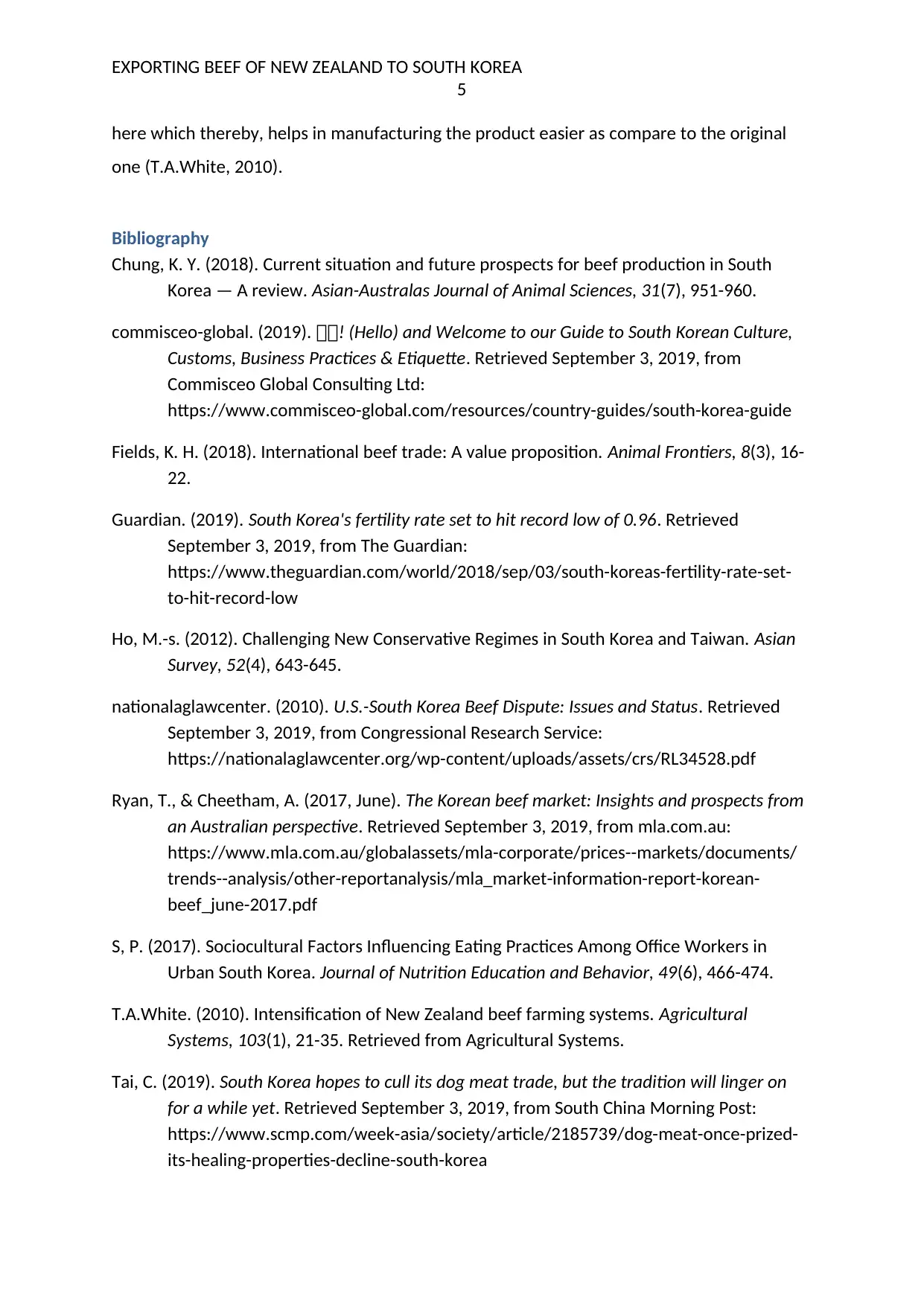
EXPORTING BEEF OF NEW ZEALAND TO SOUTH KOREA
5
here which thereby, helps in manufacturing the product easier as compare to the original
one (T.A.White, 2010).
Bibliography
Chung, K. Y. (2018). Current situation and future prospects for beef production in South
Korea — A review. Asian-Australas Journal of Animal Sciences, 31(7), 951-960.
commisceo-global. (2019). 여여! (Hello) and Welcome to our Guide to South Korean Culture,
Customs, Business Practices & Etiquette. Retrieved September 3, 2019, from
Commisceo Global Consulting Ltd:
https://www.commisceo-global.com/resources/country-guides/south-korea-guide
Fields, K. H. (2018). International beef trade: A value proposition. Animal Frontiers, 8(3), 16-
22.
Guardian. (2019). South Korea's fertility rate set to hit record low of 0.96. Retrieved
September 3, 2019, from The Guardian:
https://www.theguardian.com/world/2018/sep/03/south-koreas-fertility-rate-set-
to-hit-record-low
Ho, M.-s. (2012). Challenging New Conservative Regimes in South Korea and Taiwan. Asian
Survey, 52(4), 643-645.
nationalaglawcenter. (2010). U.S.-South Korea Beef Dispute: Issues and Status. Retrieved
September 3, 2019, from Congressional Research Service:
https://nationalaglawcenter.org/wp-content/uploads/assets/crs/RL34528.pdf
Ryan, T., & Cheetham, A. (2017, June). The Korean beef market: Insights and prospects from
an Australian perspective. Retrieved September 3, 2019, from mla.com.au:
https://www.mla.com.au/globalassets/mla-corporate/prices--markets/documents/
trends--analysis/other-reportanalysis/mla_market-information-report-korean-
beef_june-2017.pdf
S, P. (2017). Sociocultural Factors Influencing Eating Practices Among Office Workers in
Urban South Korea. Journal of Nutrition Education and Behavior, 49(6), 466-474.
T.A.White. (2010). Intensification of New Zealand beef farming systems. Agricultural
Systems, 103(1), 21-35. Retrieved from Agricultural Systems.
Tai, C. (2019). South Korea hopes to cull its dog meat trade, but the tradition will linger on
for a while yet. Retrieved September 3, 2019, from South China Morning Post:
https://www.scmp.com/week-asia/society/article/2185739/dog-meat-once-prized-
its-healing-properties-decline-south-korea
5
here which thereby, helps in manufacturing the product easier as compare to the original
one (T.A.White, 2010).
Bibliography
Chung, K. Y. (2018). Current situation and future prospects for beef production in South
Korea — A review. Asian-Australas Journal of Animal Sciences, 31(7), 951-960.
commisceo-global. (2019). 여여! (Hello) and Welcome to our Guide to South Korean Culture,
Customs, Business Practices & Etiquette. Retrieved September 3, 2019, from
Commisceo Global Consulting Ltd:
https://www.commisceo-global.com/resources/country-guides/south-korea-guide
Fields, K. H. (2018). International beef trade: A value proposition. Animal Frontiers, 8(3), 16-
22.
Guardian. (2019). South Korea's fertility rate set to hit record low of 0.96. Retrieved
September 3, 2019, from The Guardian:
https://www.theguardian.com/world/2018/sep/03/south-koreas-fertility-rate-set-
to-hit-record-low
Ho, M.-s. (2012). Challenging New Conservative Regimes in South Korea and Taiwan. Asian
Survey, 52(4), 643-645.
nationalaglawcenter. (2010). U.S.-South Korea Beef Dispute: Issues and Status. Retrieved
September 3, 2019, from Congressional Research Service:
https://nationalaglawcenter.org/wp-content/uploads/assets/crs/RL34528.pdf
Ryan, T., & Cheetham, A. (2017, June). The Korean beef market: Insights and prospects from
an Australian perspective. Retrieved September 3, 2019, from mla.com.au:
https://www.mla.com.au/globalassets/mla-corporate/prices--markets/documents/
trends--analysis/other-reportanalysis/mla_market-information-report-korean-
beef_june-2017.pdf
S, P. (2017). Sociocultural Factors Influencing Eating Practices Among Office Workers in
Urban South Korea. Journal of Nutrition Education and Behavior, 49(6), 466-474.
T.A.White. (2010). Intensification of New Zealand beef farming systems. Agricultural
Systems, 103(1), 21-35. Retrieved from Agricultural Systems.
Tai, C. (2019). South Korea hopes to cull its dog meat trade, but the tradition will linger on
for a while yet. Retrieved September 3, 2019, from South China Morning Post:
https://www.scmp.com/week-asia/society/article/2185739/dog-meat-once-prized-
its-healing-properties-decline-south-korea
⊘ This is a preview!⊘
Do you want full access?
Subscribe today to unlock all pages.

Trusted by 1+ million students worldwide

EXPORTING BEEF OF NEW ZEALAND TO SOUTH KOREA
6
6
1 out of 7
Your All-in-One AI-Powered Toolkit for Academic Success.
+13062052269
info@desklib.com
Available 24*7 on WhatsApp / Email
![[object Object]](/_next/static/media/star-bottom.7253800d.svg)
Unlock your academic potential
Copyright © 2020–2025 A2Z Services. All Rights Reserved. Developed and managed by ZUCOL.